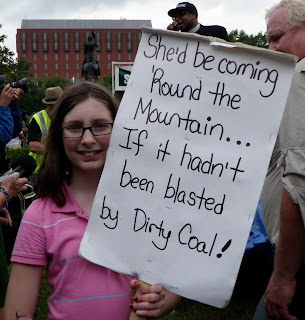Coal is America's dirtiest energy source, and the country's leading source of global warming pollution. Pollution from coal plants produces dirty air, acid rain, and contaminated land and water. The coal energy we consume locally also has other far-reaching adverse effects. A significant portion of the coal burned at the local power plants comes from the removal of mountaintops in Central Appalachia. When coal is mined, workers are subject to hazardous working conditions and commonly have health issues related to black lung disease. Coal also has to be transported long distances by rail which results in the burning and consumption of even more fossil fuels.
Coal mining has ripped apart communities. A 2011 report published by Harvard found that coal mining takes a $75 billion dollar toll on Appalachia alone each year by damaging its environment and poisoning its people. Mountaintop removal mining uses explosives to remove the tops of mountains and expose thin seams of coal. The mountaintop debris is dumped into neighboring valleys, which poses significant threats to local water supplies. According to a 2005 environmental impact statement, nearly 2,000 miles of Appalachian streams have already been buried or contaminated.
The coal industry has spent tens of millions of dollars trying to deceive the American public into believing that the age of coal is here to stay, and that the country has no other option to power its schools, places of worship, and businesses. The industry spent big because it knows that the exact opposite is true, the age of coal is over and the technologies are with us today to ditch coal for good.
At every stage of its life, coal does serious damage. Coal is the top contributor to climate change, is a leading cause of mercury pollution, and continues to scar mining communities in untold ways. Coal is also a threat to our economic security. The Harvard report found that “the life cycle effects of coal and the waste stream generated are costing the U.S. public a third to over one-half of a trillion dollars annually.”

No comments:
Post a Comment